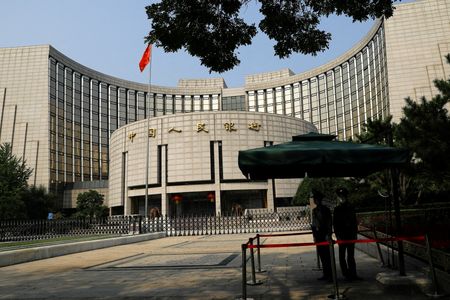SHANGHAI/SINGAPORE (Reuters) – China’s central bank unexpectedly cut key policy rates for the second time in three months on Tuesday, in a fresh sign that the authorities are ramping up monetary easing efforts to boost a sputtering economic recovery.
Analysts said the move opened the door to a potential cut in China’s lending benchmark loan prime rate (LPR) next week.
Tumbling credit growth and rising deflation risks in July necessitated more monetary easing measures to arrest the slowdown, market watchers said, while default risks at some housing developers and missed payments by a private wealth manager also affected financial market confidence.
“All of these add to the urgency that policymakers need to act fast before consumer and business confidence deteriorate sharply,” said Tommy Wu, senior China economist at Commerzbank.
The People’s Bank of China (PBOC) said it lowered the rate on 401 billion yuan ($55.25 billion) worth of one-year medium-term lending facility (MLF) loans to some financial institutions by 15 basis points to 2.50% from 2.65% previously.
The cash injection was to counteract factors including tax payments in order to “keep banking system liquidity reasonably ample”, the PBOC said in an online statement.
In a Reuters poll of 26 market watchers conducted this week, 20 participants, or 77%, predicted that the central bank would leave the MLF rate unchanged. Only six respondents forecast a marginal rate reduction.
“The surprising rate cut was a prompt response to support subdued credit data and China recovery (that) may unleash yuan depreciation pressure towards 7.3,” said Ken Cheung, chief Asian FX strategist at Mizuho Bank.
“In particularly, the PBOC may intend to support the medium-term credit conditions via the asymmetric cut, and opened the way for a cut to LPR, especially the 5-year LPR, to support the struggling property sector.”
The MLF rate serves as a guide to the LPR and markets mostly use the medium-term policy rate as a precursor to any changes to the lending benchmarks. The monthly fixing of the LPR is due next Monday.
The central bank also injected 204 billion yuan through seven-day reverse repos while cutting borrowing costs by 10 basis points to 1.80% from 1.90% previously, it said in an online statement.
China remains an outlier among global central banks as it has loosened monetary policy to shore up a stalling recovery whereas others have been in tightening cycles as they battle high inflation.
Tuesday’s rate move has widened the yield gap with other major economies, particularly the United States, putting more pressure on the yuan and risking outflows.
China’s yuan has lost about 5% against the dollar so far this year to become one of the worst performing Asian currencies. The yuan traded at 7.2842 per dollar as of 0145 GMT, compared with the previous close of 7.2580. [CNY/]
Yields on China’s 10-year government bonds eased to 2.56%, the lowest level since May 2020.
The PBOC lowered key policy rates in June to prop up the broad economy, but data has been increasingly weak since.
($1 = 7.2585 Chinese yuan)
(Reporting by Winni Zhou and Rae Wee; Editing by Kim Coghill and Jamie Freed)





